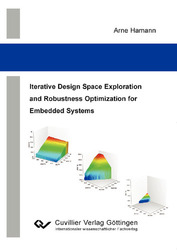| Areas | |
|---|---|
| Serie de libros (96) |
1378
|
| Nachhaltigkeit |
3
|
| Gesundheitswesen |
1
|
| Letra |
2365
|
| Ciencias Naturales |
5406
|
| Matemática | 229 |
| Informática | 319 |
| Física | 980 |
| Química | 1363 |
| Geociencias | 131 |
| Medicina humana | 243 |
| Estomatología | 10 |
| Veterinaria | 108 |
| Farmacia | 147 |
| Biología | 835 |
| Bioquímica, biología molecular, tecnología genética | 121 |
| Biofísica | 25 |
| Nutrición | 45 |
| Agricultura | 1004 |
| Silvicultura | 201 |
| Horticultura | 20 |
| Ecología y conservación de la tierra | 148 |
| Ciencias Ingeniería |
1793
|
| General |
98
|
|
Leitlinien Unfallchirurgie
5. Auflage bestellen |
|
Erweiterte Suche
Iterative Design Space Exploration and Robustness Optimization for Embedded Systems (Tienda española)
Arne Hamann (Autor)Previo
Indice, Datei (52 KB)
Lectura de prueba, Datei (230 KB)
An embedded system is a micro computer system that is embedded into another technical device that itself does not appear as a computer. Embedded systems can be found everywhere and are going to be even more pervasive in the near future. Examples are telecommunication devices, consumer electronics, automotive systems, building technology, etc. Embedded systems have a very high influence on the system industry. Nowadays, modern products cannot be realized in a competitive manner without embedded micro computer systems.
In order to meet growing productivity demands and cost pressure, embedded systems need to be designed very efficiently. Obviously, due to the increasing complexity and distributed nature of modern systems this is by far no easy task. One key factor to increase the development process efficiency of complex distributed embedded systems is reuse. Concepts like the platform-based design style and standardization efforts on the software level (e.g. the AUTOSAR initiative in the automotive domain) allow to conceive whole product families and variants based on the same set of reusable components and sub-systems. However, while reuse helps to increase design efficiency at the functional level, it does not solve another key embedded systems challenge that arises with system complexity and sub-system integration: the control of non-functional properties, such as timing, power consumption, or dependability.
The benefits of controlling non-functional properties early in the design flow are clear. First, it helps the designer to take the right design decisions before proceeding to implementation, and thus to decrease the design risk and costs. Second, it assists the designer in conceiving systems with performance head-room for future extensions, updates, and bug-fixes. Achieving this is not trivial, since system performance is fragile with respect to modifications to the specification. Even slight changes of properties, such as execution demands, communication volumes, data rates, etc., can have severe impact on system performance. As a consequence, it is desirable that the system exhibits some sort of “robustness” towards changes.
| ISBN-10 (Impresion) | 3867278199 |
| ISBN-13 (Impresion) | 9783867278195 |
| ISBN-13 (E-Book) | 9783736928190 |
| Formato | A5 |
| Idioma | Inglés |
| Numero de paginas | 232 |
| Edicion | 1 Aufl. |
| Volumen | 0 |
| Lugar de publicacion | Göttingen |
| Lugar de la disertacion | TU Braunschweig |
| Fecha de publicacion | 11.12.2008 |
| Clasificacion simple | Tesis doctoral |
| Area |
Informática
Ingeniería eléctrica |








